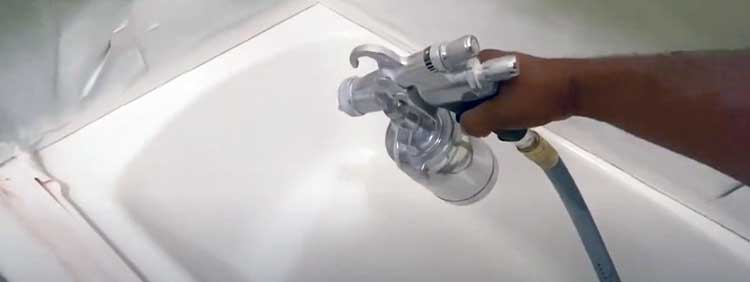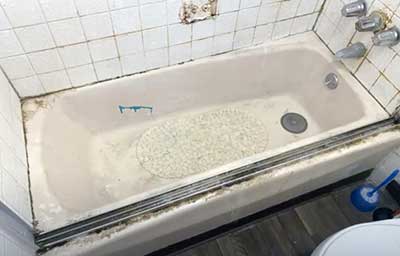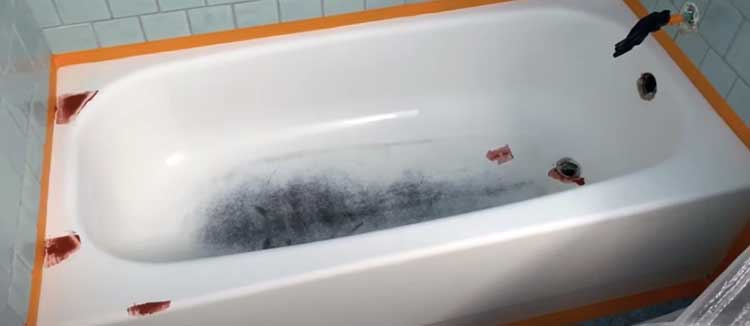Now, if you are planning to retain the lost glaze of your bathtub, there are several bathtub renovation techniques to do it. Bathtub glazing is just of those techniques that are cheap yet effective.
However, there are some bathtub reglazing problems too, that you should be aware of.
In this article, I’ll talk about all the potential problems you can face after you reglazed your luxurious bathtub with solutions. So, without wasting any time, let’s dive in.
Drawbacks To Bathroom Reglazing

After knowing what bathroom reglazing is and its benefits, don’t get too excited just yet. You have to accept that reglazing might not always turn out to be perfect.
Right now, reglazing jobs don’t require any certifications or licenses to perform professionally. That means absolutely anyone can get into this line of work.
So, before you appoint a refinisher for reglazing, make sure he has prior experience in this line. Otherwise, that person can worsen the condition of the bathtub and cost you money.
Assuming you have hired the best, you should always prepare for the worst. So, knowing about the potential bathtub reglazing problems will give you a heads up and help you solve the problems.
- Bubbling
Bubbling is one of the most common problems you can face after reglazing a bathtub. As mentioned earlier, reglazing needs layers of primer and paint.
If the layers are not applier properly and there is air in between, bubbles start to pop up.
Another potential reason for bubbling is if the refinisher doesn’t sand the surface properly or strip the previous reglaze before proceeding.
Without stripping, the previous glaze can generate a chemical reaction with current primer and paint layers, causing bubbles to appear.
Solution: Applying the coatings properly and letting them dry is the only solution to this problem. Besides, make sure your reglazing guy strips the tub before applying a new layer.
- Fading

Among different problems caused by thin layers of coating, fading is most likely to happen.
Therefore, after reglazing is done, a sealer is applied on the surface so that the layers underneath stay intact.
Also, if the coating is mixed incorrectly or applied in a thin layer, it tends to wear off after some time.
This wear-off is known as fading as the final coating starts to fade away and the layers start to come through.
Also, fading is likely to happen if you don’t give the coating time to cure properly or use incompatible cleaners.
If fading occurs, the bathtub runs into the risk of having cracks and scratches again.
Solution: The solution to fading is pretty straightforward. You have to hire professionals who can apply the coating properly and mix the right amount of materials for the coating.
From your end, make sure you give the coating enough time to cure and don’t use an abrasive cleaner on the reglazed surface. And copper bathtubs don’t have this problem at all.
- Sticky Feel
It is only normal to expect a polished feel when using the bathtub after reglazing. But that might not be the case always as the surface may feel sticky sometimes.
Not giving enough time to cure is the most obvious reason for this stickiness. Also, if the finishing coating is not applied properly, that can be another potential cause.
Solution: If the reglaze feels sticky, the first thing to do is not panic. Then, give the bathtub reglazing curing time, maybe another 24 hours, as the curing takes extra time depending on the humidity level.
If the problem still persists, then you might have to call your refinisher gin to respray the finish.
- Rough Texture
A reglazed bathtub should give you the exact feel of a new one. Instead, if the surface feels unpolished and rough, that indicates a potential problem in reglazing.
If dust and debris around your bathroom get stuck underneath the finish, it can cause this rough texture. Also, if the tub’s surface is not sanded properly, that can be another potential reason.
Solution: As it’s impossible to create a completely dust-free environment, you have to accept minor flaws. But if it starts to feel uncomfortable to bathe in, it should be considered a problem.
The solution to this problem is properly sanding the tub and cleaning it before applying the coating.
- Peeling
Reglazed tub peeling happens if a chip on the surface pops off through the coatings. Over time, this chip can loosen the entire layer, and the coating starts to come off.
So, how the chip is even there? Poor preparation is responsible for that as it didn’t remove the chip in the first place.
Solution: The solution to this problem is pretty simple. Make sure your reglazing professional is preparing the surface properly before starting reglazing.
As you can see here, poor preparation can turn into bigger issues and mess the whole thing up.
- Chipping
Neither the tub itself nor the coating applied on them can withstand heavy pressure exerted on them. So, if you drop something heavy in the tub before the reglazing cures properly, that can cause a dent on the surface, commonly referred to as chips.
With something heavy enough, it can even happen on a cured reglazed bathtub.
Solution: Reapplying the finish with a blending solvent is the most common way to hide the chipping. If that doesn’t work, you might need to apply a new coating on the tub.
Whatever you decide to do, do it fast. Otherwise, the chipping can further damage the rest of the reglazed areas.
Re-examining Bathtub Reglazing

Before we head into the problems and the solutions, let’s get a clear idea about what bathtub reglazing is. This way, it’ll be easier for you to relate and understand the problems as we advance.
As said before, bathtub reglazing is just one of many ways of renovating your old bathtub. You might also now reglazing as refinishing or recoating too.
No matter how carefully you use your bathtub, it loses its glaze over time. As a result, scratches, cracks, and stains start to take place on the surface of the tub.
Reglazing can allow you to remove all these from your bathtub quickly at a fairly low cost.
The first step of reglazing involves sanding the whole bathtub to get rid of chips and scratches. Then when the surface is smooth, layers of primer and paint are applied to fill up the cracks and buff the surface.
If done properly with professional refinishers, reglazing can make your bathtub look new again.
Benefits And Drawbacks Of Reglazing Your Bathtub
Now we know that reglazing can retain the old look of your bathtub by removing all the scratches, cracks, and stains.
But have you ever thought about what makes this renovation technique so popular among homeowners? Looking at reglazing bathtub pros and cons might help us find the answer.
Pros of Reglazing Bathtub
- Cost-Effective
The first reason why bathtub reglazing is so popular is the cost-effectiveness. Let’s think about changing the whole tub for a moment.
Apart from buying a new bathtub, installing it comes with supplementary costs too.
Even if you go for the cheapest options on the market, it’ll cost you hundreds if not thousands of dollars. For example, a plumber needs to remove the old bathtub and install the new one for days, which will cost you money.
On top of that, even carrying the bathtubs in and out will require a workforce too. But, on the other hand, you’ll only need a fraction of the replacement cost to reglaze the bathtub.
- Bathroom Availability and Completion Time
Then comes the availability factor of your bathroom, another benefit of bathtub reglazing. If you decide to replace the tub, it can put your bathroom out of commission for days with a messed-up plumbing system.
Additionally, a plumber will work there, so you won’t be able to use the washroom for at least three days before the replacement is complete.
I agree most reglazing projects take two to three days to complete fully with drying. This period may make it seem like the same thing.
But actually, reglazing is done within a day, and drying the paint takes up the rest of the time. That means the bathroom remains available for you.
Cons of Reglazing Bathtub
There is no doubt that reglazing is a great way to increase the lifespan of your bathtub. But can it match the quality of a replaced bathtub? Definitely not, as a new bathtubs finish will last longer.
The whole bathtub reglazing process involves some pretty hard chemicals. So, is it safe to bathe in a reglazed bathtub? Yes, if the reglazing is done properly.
Otherwise, exposure to those chemicals can result in serious injury.
Final Thought
Here we are at the end of your article. As you can see, even little miscalculations or mistakes in the reglazing process can cause bigger problems to ruin the whole project.
However, one thing to remember here is that not everyone will face these bathtub reglazing problems.
For the most part, it depends on the person who has done the glazing. If you can hire a professional with a reputation in this field, you should easily dodge these issues.
